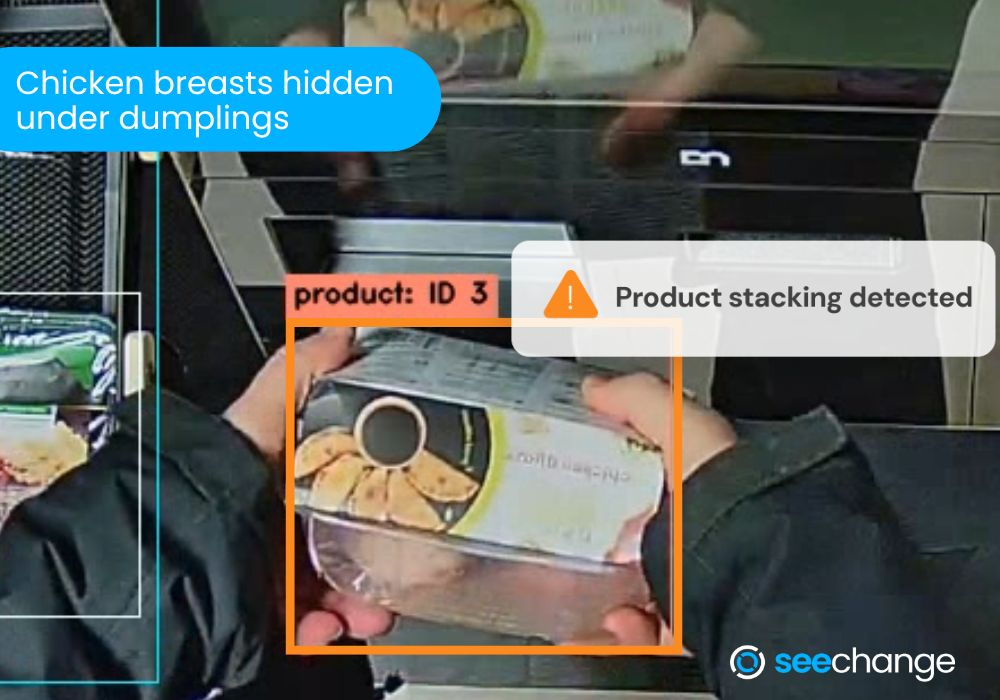Self-checkout 2.0: Revolutionizing retail security and the customer experience
18th September 2024

Modernising self-checkout security: Why now is the time for change
Retailers today are walking a tightrope, balancing the demand for frictionless customer experiences with the urgent need to reduce shrink. While headlines suggest self-checkout deployments are declining, the reality is more nuanced: self-checkout adoption is still growing – but the technology must evolve.
Retailers can no longer afford systems that increase shrink, frustrate shoppers, and overload employees.
That’s where Vision AI-powered self-checkout security comes in. By combining real-time computer vision, machine learning, modern systems detect theft as it happens, nudging shoppers to correct errors, reducing interventions, and restoring trust in the formats ability to deliver on operational efficiency.
In this guide, we explore:
- The most common types of self-checkout theft (intentional and accidental)
- Why traditional self-checkouts are vulnerable
- How next-gen, Vision AI-powered self-checkouts prevent loss and improve experience.
Quick fact: Self-checkout adoption has increased by 74% across global retailers in the past two years. This format isn’t going away, but it must get smarter.
A brief self-checkout history
Invented by David R. Humble, the first self-checkout was introduced to the public in 1986. At that time 38% of store customers favoured the self-checkout, laying the foundation for a checkout revolution.
Since then, self-checkout technology has evolved into a competitive market, with providers like NCR, Diebold Nixdorf and Toshiba vying for dominance. In 2023, 217,000 self-checkout units were delivered worldwide according to RBR data services, an increase of 17,000 on the year before.
The appeal of traditional self-checkout lies in its ability to improve efficiency, reduce labour costs, and accelerate transactions. However, first generation self-checkouts often fall short of reaching their full potential due to challenges like weigh scale errors and item mis-identification, which frequently require employee intervention. This not only creates friction in the customer experience but also contributes to increased shrinkage – a critical concern for retailers.
Like many innovations that propel us forward, we often take a step back before making further progress. As pressure to maximise ROI grows, addressing these security vulnerabilities and performance limitations through smart automation becomes essential for maintaining profitability and reducing losses.
Are retailers really removing self-checkout?
Media headlines may suggest that self-checkouts are being phased out, but a closer look at the data reveals a different reality. While some retailers have reassessed their first generation self-checkout deployments due to customer experience concerns, feedback and perceived shrink increases, the broader trend tells a positive story. According to RBR, global self-checkout deliveries grew by 12% in 2023 compared to 2022, with the U.S. emerging as the largest market seeing a 5% increase in shipments.
The truth is, retailers are not abandoning self-checkouts. They are, however, more aware of rising shrinkage concerns linked to first-generation systems and shopper backlash due to employee interventions that gets in the way of the promised convenience.
The focus now is on delivering the next generation of smarter self-checkouts as part of a larger, more comprehensive loss prevention and security strategy.
How common is fraud and theft at self-checkout?
As first-generation self-checkout systems have become increasingly prevalent, they have also become a new source of shrinkage for retailers. Theft at self-checkout occurs when customers intentionally or unintentionally exploit the systems vulnerabilities.
According to new UK research from Ipsos, one in eight adults (13% of those polled) admit to selecting a cheaper item on self-checkout than the one they were buying. Additionally, 26% of those polled said they have accidentally not paid for an item when shopping. Research for the Grocer suggests that 37% of shoppers have failed to scan an item, with Matt Hopkins, associate profession in criminology at the University of Leicester suggesting that self-checkouts create opportunities for people to steal who otherwise would not consider shoplifting.
To learn more about how the next generation of AI-powered self-checkouts combats fraud, skip to “Smart Automation.”
Common types of self-checkout theft and fraud
To effectively combat theft and fraud, retailers must understand the common tactics used to exploit first-generation self-checkouts. Here are some common types of self-checkout fraud:
- The banana trick
- Product stacking
- Skip scanning or missed scans
- Walkaways
- Barcode switching
- Unintentional

What is the banana trick on self-checkout
The “banana trick” involves fraudulently ringing up an expensive item as a cheaper one. For example, a customer might place an alcohol bottle on the scale but select a low-cost fruit like bananas on the touchscreen, paying only for the weight of the cheaper item.
What is product stacking
Product stacking involves scanning only the bottom item of a stack while bagging multiple products. For instance, a customer might stack meat packets and scan only the bottom one, resulting in theft of the other items if the weigh scale error is overlooked.
What is skip scanning or missed scans
Skip scanning, missed scans, or ‘the pass-around’ occurs when customers position the barcode away from the scanner, cover it with their hand, or directly place the item in their bag without scanning it.
What are walkaways
Walkaways happen when customers cancel their payment method or abandon the self-checkout mid-transaction. This can disrupt the process, causing the next customer to potentially pay for items left behind. Either the retailer experiences losses, or they face disgruntled customers who have paid for items they didn’t select.
What is barcode switching
Barcode switching, also known as ‘the switcheroo’, occurs when a customer scans the barcode of a cheaper item but bags a more expensive one, such as scanning a discount wine bottle while taking a premium bottle.
What is unintentional theft and fraud
Unintentional theft often results from user error rather than deliberate fraud. Common issues include selecting the wrong item from a screen-displayed catalogue, failing to scan an item before bagging it, or forgetting items stowed in bags or pushchairs.
What are the security measures at self-checkout?
Self-checkout systems have advanced significantly, and so have the security measures designed to protect them. Initially, traditional methods in first generation systems like weigh scales and attendant oversight provided basic protection but were often reactive and limited. Weigh scales could detect weight discrepancies but couldn’t verify item accuracy, leaving room for fraud techniques like barcode switching and the “banana trick.”
Today, AI-powered solutions represent the next generation of self-checkout security, offering automation and a more proactive approach. These systems use real-time data analysis and machine learning to detect suspicious behaviour, with technologies like computer vision cross-referencing visual data with scanned barcodes to enhance accuracy and reduce fraud.
Here’s an overview of some common security features, both traditional and modern, along with their limitations:
- Cameras
- Weigh scales
- Attendants
- Random bag checks
- Item limits (20 items or less)
- Computer Vision technology
Cameras
A common question is, “Are there cameras in self-checkout systems?” For many self-checkout systems, the answer is yes. Some feature customer-facing cameras, designed to deter theft by showing customers their image. However, these cameras are often insufficient for seasoned shoplifters. More advanced systems now integrate cameras with computer vision solutions to improve security.
Weigh scales
Weigh scales are a primary security measure that compares the weight of scanned items against a database. While effective for catching some errors, they can’t prevent fraud techniques like barcode switching or the “banana trick,” as they confirm weight but not item accuracy.
Attendants
Attendants provide assistance and act as a deterrent. However, they are often occupied with other tasks, leaving opportunities for theft. Experienced shoplifters can exploit less monitored self-checkouts, regardless of attendant presence.
Random bag checks
Random bag checks aim to catch potential shoplifters but can frustrate legitimate customers and lead to longer wait times. Targeted checks based on suspicious transactions might offer a more efficient approach.
Item limits
To curb theft, some retailers limit the number of items processed through self-checkout. While this can reduce theft risk, it may frustrate customers with larger purchases and undermine the convenience of self-checkouts.
Computer vision technology and AI
Computer vision technology together with AI represents a significant advancement in self-checkout security and shopper experience. By analyzing shopper behavior and product handling in real-time, they can detect fraudulent activities like barcode switching and item misplacement as well as automate key processes such as item look-up.
What is a computer vision powered self-checkout?
Next generation checkouts integrate advanced AI and computer vision with traditional security measures. These modern systems address many of the shortcomings of first-generation models, offering enhanced capabilities for theft detection, accuracy improvement, and operational efficiency. Unlike their predecessors, AI-powered self-checkouts not only shorten wait times and improve customer experience but also provide advanced tools for tackling modern retail challenges. By aggregating trends across stores, the insight gathered at each self-checkout also enables retailers to identify and anticipate emerging trends and behavior patterns.
What are the benefits of AI powered self-checkout?
By integrating computer vision, retailers can address the limitations of traditional self-checkout head-on. Cameras and sensors help the system detect real-time issues—. With computer vision, the system can intelligently differentiate between such events and genuine discrepancies, allowing the transaction to continue smoothly. Additionally, self-checkouts which have fully integrated computer vision can nudge customers to scan missed items, reducing shrinkage by up to 80% as most customers correct these mistakes when prompted.
Benefits include:
- Comprehensive sensor integration to provide more nuanced fraud event detection
- Real-time fraud detection
- Trend spotting and operational efficiency
- Enhanced customer experience
Comprehensive sensor integration to provide more nuanced fraud event detection
Computer vision AI-powered checkouts utilize all the conventional tools—such as weigh scales, cameras, and barcode scanners—but enhance them with AI-driven processing. These systems can intelligently cross-reference data from various sources, such as comparing scanned items’ weights with visual data to ensure that the correct products are being checked out. This integration reduces the chances of common fraud tactics, like barcode switching or item misrepresentation, going unnoticed.
In an article by France Bleu, Laurent Hugou, director of Intermarché La Farlède, highlights the effectiveness of this technology following a recent deployment in-store: “The objective of these cameras is clear: to detect unscanned items. We clearly differentiate between intentional and unintentional fraud. There are often items that are not scanned due to handling errors. Typically, the most common error concerns avocados! Customers don’t know if it’s a fruit or a vegetable… But all of this causes losses for the store of up to 3% of all transactions. Since these cameras were installed, this figure has been halved and our goal is to get it below 1%.”
Real-time fraud detection
Unlike traditional systems that operate on simple rules, computer vision AI-powered self-checkouts detect patterns and behaviors in real-time. For instance, if a customer repeatedly scans items in an unusual manner or if an item’s appearance doesn’t match its barcode, the system can flag the transaction for review before the customer leaves the store. This proactive approach not only deters theft but also allows for immediate intervention, reducing the likelihood of loss.
Trend spotting and operational efficiency
Beyond preventing theft, computer vision AI-powered systems can help retailers to identify trends in customer behavior, helping retailers optimize their operations. For example, the system might detect that certain products are frequently involved in fraudulent activities or that specific times of day see higher rates of suspicious behaviour. Retailers can use these insights to adjust their security measures, improve store layouts, and even tailor staff deployment to better protect assets.
Enhanced customer experience
AI-powered self-checkouts improve the customer experience by removing unnecessary employee interventions and automating key processes such as item lookup. This efficiency reduces the need for random bag checks and item limits, which can frustrate customers. Instead, these systems provide a smoother, more efficient shopping experience while maintaining robust security.
Computer vision AI-powered self-checkouts offer a more intelligent, responsive, and customer friendly approach to managing transactions. By combining traditional security measures with AI, retailers can significantly reduce theft and fraud at self-checkout and in-store while enhancing the overall shopping experience.
If computer vision is that amazing, why doesn’t every self-checkout already come with it?
Despite the clear advantages of computer vision AI-powered self-checkouts—such as enhanced security, streamlined operations, and improved customer experiences—retailers’ adoption to date has been slow. Several barriers have slowed its integration into the retail landscape, including:
Privacy concerns: In the past, privacy concerns were a major hurdle for retailers adopting computer vision AI. Today, advancements in data protection and industry regulations, such as ISO 27001 certification, ensure that sensitive data is securely managed. This internationally recognized standard demonstrates robust safeguards, giving both retailers and consumers confidence that their information is protected.
Cost and integration challenges: Initially, deploying computer vision AI required investment in new infrastructure, such as GPU servers, dedicated cameras or technology to be installed by the retailer for its checkouts at each store. This is now remedied as leading self-checkout suppliers, such as Diebold Nixdorf, partner with AI solution providers to embed computer vision directly into their offer, removing the complexity of deployment and making network-wide rollout a viable option
Siloed and off-the-shelf systems: Retailers need solutions that scale and can be adapted to their specific operations. Off-the-shelf systems often lack the flexibility to handle diverse store environments, while siloed systems create fragmented data and hinder a unified view of business operations. To address this, retailers are now seeking to flex their deployments.
A configurable rules-based approach gives retailers the flexibility to tailor how the technology responds in real-time. For instance, retailers can adjust the number of customer nudges before requiring employee intervention or minimize interventions during peak times to keep queues short.
Without this level of flexibility, rigid, one-size fits all solutions fall short of delivering the desired operational efficiency and actionable insights retailers need.
Computer vision AI and the future of retail
After years of technology trials, the benefits of computer vision AI in retail are becoming increasingly evident. Many traditional barriers to entry—such as high costs, complex infrastructure, and siloed systems—are being systematically dismantled. Integration partnerships between self-checkout suppliers and AI solution providers, like Diebold Nixdorf and SeeChange, have further streamlined deployments, driving down costs and making this transformative technology more accessible to retailers of all sizes.
Retailers understand that for every security measure in place to minimize losses, there will always be those seeking to exploit weaknesses. For businesses committed to loss prevention, this means taking a whole-store approach—deploying technology that not only addresses current challenges but also adapts to emerging threats. With a platform approach to computer vision AI deployments, retailers can stay ahead of evolving fraud tactics, adding new use cases as needed to ensure robust protection.
Forward-thinking retailers are already exploring ways to integrate these next generation self-checkouts into a unified, intelligent store ecosystem. The future is clear: those who embrace computer vision AI will lead the charge in enhancing efficiency, reducing shrink, and improving the overall customer experience.

